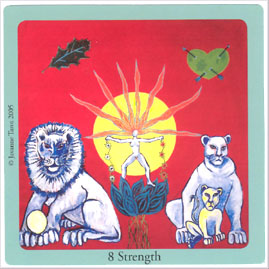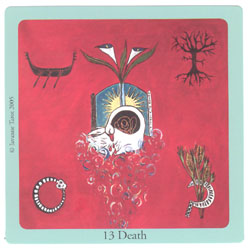|
 New tarot decks from Denmark are not an everyday occurrence. Apart from the very limited and
partly handmade art tarot majors I have been involved with myself, I can not remember if any tarot
decks were published in Denmark since Erwin Neutzsky Wulff's "Tarot" from 1986. That was 20 years ago
and Wulff's black and white deck did long ago fall into oblivion.
New tarot decks from Denmark are not an everyday occurrence. Apart from the very limited and
partly handmade art tarot majors I have been involved with myself, I can not remember if any tarot
decks were published in Denmark since Erwin Neutzsky Wulff's "Tarot" from 1986. That was 20 years ago
and Wulff's black and white deck did long ago fall into oblivion.
We are now enriched with a new Danish tarot deck, published back in 2005 actually, but the news about
it only reached me recently. As the readers of this column will know, I am in general rather
skeptical and hesitant towards most tarot decks published these years, where the tarot market is
dominated by a few commercial publishers, whose products are all hastily manufactured to satisfy
their customers' alleged demand.
 I was pleasantly surprised when the package with the "Javanne Tarot" and its accompanying book arrived.
This is no mass market tarot, it is not a hasty computer creation; the originals for the 78 cards were
painted with acrylics on canvas in a relatively large format (60x60 centimetre, about 2x2 feet) and they
have been worked upon carefully for seven years by its two creators: author and tarot reader Karen
Javanna Jordell and art therapist and artist Annelie Zofia Bisgaard.
I was pleasantly surprised when the package with the "Javanne Tarot" and its accompanying book arrived.
This is no mass market tarot, it is not a hasty computer creation; the originals for the 78 cards were
painted with acrylics on canvas in a relatively large format (60x60 centimetre, about 2x2 feet) and they
have been worked upon carefully for seven years by its two creators: author and tarot reader Karen
Javanna Jordell and art therapist and artist Annelie Zofia Bisgaard.
What strikes me at first sight is that the cards, which come in a cloth pouch, are in a square format
(90x90 millimetres, approx. 3½ inch). Unusual format, though not entirely unknown. In this case the
format is, however, part of the suggested way of interpreting the cards; there is no longer only a
right or reverse position possible in a card spread, but the cards can be placed in four different
positions, depending on what side the card's central figure points: upwards, to the left, downwards or
to the right. In a diagram in the beginning of the book, Karen Javanna illustrates this idea, which
is based upon values of the four elements. Here I could, however, have used a more clarifying explanation.
 Two card spreads, the Celtic Cross and a four elements spread are explained, taking the four possible
positions of the Javanne Tarot into consideration. The remaining book, about 100 pages, goes over all
78 cards in detail with a general description of each card and its inherent symbolism plus a text for
each of the four possible positions the card can be placed in. Javanne Tarot is based upon symbols,
and the nature of symbols is, that they are expressions of ideas and thoughts. A symbol can not
immediately be expressed or explained in words, but it carries with it a unique meaning for the
individual.
Two card spreads, the Celtic Cross and a four elements spread are explained, taking the four possible
positions of the Javanne Tarot into consideration. The remaining book, about 100 pages, goes over all
78 cards in detail with a general description of each card and its inherent symbolism plus a text for
each of the four possible positions the card can be placed in. Javanne Tarot is based upon symbols,
and the nature of symbols is, that they are expressions of ideas and thoughts. A symbol can not
immediately be expressed or explained in words, but it carries with it a unique meaning for the
individual.
 Let us take a look at the cards. Annelie Zofia Bisgaard, who painted the original Javanne Tarot images,
can hardly be called a great artist. She is an art therapist. She can, however, be called a good artist
and a great tarot artist, because she has understood the obstacles which have to be overcome to create
a large size painting that has to be reduced to a small printed card size. We have too often seen,
that well-known artists have not been able to do this, resulting in mediocre card size renderings of
their original work. Annelie Zofia's illustrations are very detailed with tiny figures and symbols,
which all have their meaning. As such they need to be seen clearly even in the reduced image, which
the card size is. They are, simple and bright on a coloured background. Figures only a few centimetres
or less stand out clearly and leave no doubt of what we see. It's all there. Amazingly also, that when
a card has a value of, for example 8 shields, there are 8 shields rendered. Not a matter of course
these days.
Let us take a look at the cards. Annelie Zofia Bisgaard, who painted the original Javanne Tarot images,
can hardly be called a great artist. She is an art therapist. She can, however, be called a good artist
and a great tarot artist, because she has understood the obstacles which have to be overcome to create
a large size painting that has to be reduced to a small printed card size. We have too often seen,
that well-known artists have not been able to do this, resulting in mediocre card size renderings of
their original work. Annelie Zofia's illustrations are very detailed with tiny figures and symbols,
which all have their meaning. As such they need to be seen clearly even in the reduced image, which
the card size is. They are, simple and bright on a coloured background. Figures only a few centimetres
or less stand out clearly and leave no doubt of what we see. It's all there. Amazingly also, that when
a card has a value of, for example 8 shields, there are 8 shields rendered. Not a matter of course
these days.
The symbols rendered are universal and archetypical. Some of them can be recognized as images inspired
by the lost Danish national treasure, the Golden Horns of Gallehus, others from the shamans' drums,
from Hopi Indian lore, from alchemy and rock carvings. Others are not immediately recognizable but yet
they feel well-known to us. We are back to what tarot decks were intended as: a pack of symbols on
which the individual could hang her own feelings and interpretation. For the same reason the
characters depicted do not have facial traits the reader can identify with. We do not need a historical,
feministic, gay, ethnic, literary, Egyptian, multicultural or whatever framework to hang tarot symbolism
upon.
Then where do we find traces of Waite-Smith? Well, it takes an extra look, but they are there,
of course. In 6, 7 and 8 of swords, for example.
I'm not much nationalistic minded, particularly in these days where stated nationalism in this country,
due to our current government's supporting party, is equal with racism, but I am pleased to know, that
one of the most positive tarot reviews I have written in recent years concerns a deck that originates
in this small country.
|